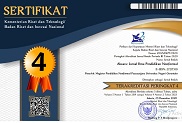Handling Juvenile Delinquency: The Role of the Social Welfare Service in Handling Cases in Samarinda City
Abstract
The purpose of this research is to examine the prevention of juvenile delinquency by the Department of Social Welfare in handling cases in Samarinda City. This type of qualitative descriptive research focuses on the empowerment and obstacles faced by the Office of Social Welfare. This research has been carried out from October to January 2022. The primary data sources are the head of the service, the head of the rehabilitation section for children and the elderly, social workers and counseling. Data collection techniques through observation, interviews, and documentation. Data analysis techniques through reduction, display and conclusion. The validity of the data using data triangulation. The results of the study, adolescent empowerment will have implications in developing the mindset of youth independence so that they have the ability to work and gain experience. Barriers: on the financial aspect, human resources, shelter, the role of parents and public awareness. The practical implication is that this research can be piloted in a youth development social home in handling delinquency cases delegated from the Samarinda Class II Child Special Guidance Institute in Tenggarong.
Â
Keywords
Full Text:
PDFReferences
Ahmed, U., & Murtaza, A. (2016). Factors affecting juvenile delinquency in Punjab, Pakistan: a case study conducted at juvenile prisons in Punjab province. Mediterranean Journal of Social Sciences, 7(4), 372.
Anjaswarni, T., Nursalam, N., Widati, S., & Yusuf, A. (2019). Analysis of the Risk Factors Related to the Occurrence of Juvenile Delinquency Behavior. Journal of Ners, 14(2).
Bahzar, Moh. (2020). Teacher' S Engagement For Knowledge Management: New Insight For Professional.
Bahzar, Muhammad, & Kusuma, AR (2013). Role of Leadership Style on Organizational Performance in Determining the University of 17 August 1945 Samarinda. 3(3), 1057-1066.
Binik, O., Ceretti, A., Cornelli, R., Schadee, H., Verde, A., & Gatti, U. (2019). Neighborhood social capital, juvenile delinquency, and victimization: Results from the international self-report delinquency study-3 in 23 countries. European Journal on Criminal Policy and Research, 25(3), 241-258.
Burgess, EW (1916). Juvenile delinquency in a small city. Journal of the American Institute of Criminal Law and Criminology, 6(5), 724-728.
Doelman, EHJ, Luijk, MPCM, Haen Marshall, I., Jongerling, J., Enzmann, D., & Steketee, MJ (2021). The association between child maltreatment and juvenile delinquency in the context of Situational Action Theory: Crime propensity and criminogenic exposure as mediators in a sample of European youth? European Journal of Criminology, 14773708211013300.
Griffiths, P. (2017). Juvenile delinquency in time. In Becoming Delinquent: British and European Youth, 1650-1950 (pp. 35-52). Routledge.
Jawatir Pardosi. Rudi Agung Nugroho, Rita Mariati, J. (2021). Training and mentoring of young entrepreneurs at Mulawarman University. 5, 394-399.
Liu, L., & Miller, SL (2020). Protective factors against juvenile delinquency: Exploring gender with a nationally representative sample of youth. Social Science Research, 86, 102376.
Moh. Bahzar. (2014). Building Nationalism in Border Areas Through Strengthening Social Capital. In Proceedings of the IV Pancasila Congress (pp. 4-19).
Nurochman, H., & Setiawan, MA (2019). The Role of the Counselor in Combating Free Association Among Adolescents (Case Study at SMA Muhammadiyah 2 Palangkaraya). Suluh: Journal of Guidance And Counseling, 4(2), 14-20.
Pardini, D. (2016). Empirically based strategies for preventing juvenile delinquency. Child and Adolescent Psychiatric Clinics, 25(2), 257-268.
Rekker, R., Pardini, D., Keijsers, L., Branje, S., Loeber, R., & Meeus, W. (2015). Moving in and out of poverty: The within-individual association between socioeconomic status and juvenile delinquency. PLoS One, 10(11), e0136461.
Rhoades, KA, Leve, LD, Eddy, JM, & Chamberlain, P. (2016). Predicting the transition from juvenile delinquency to adult criminality: Gender-specific influences in two high-risk samples. Criminal Behavior and Mental Health, 26(5), 336-351.
Semenza, DC (2018). Health behaviors and juvenile delinquency. Crime & Delinquency, 64(11), 1394-1416.
Shoemaker, DJ (2017). Juvenile delinquency. Rowman & Littlefield.
Thompson, WE, & Bynum, JE (2016). Juvenile delinquency: A sociological approach. Rowman & Littlefield.
Warman. (2021). Establishing the governmental policy to promote engagement within the inclusive education system in Indonesia. Journal of Social Studies Education Research, 12(1), 124-148.
DOI: http://dx.doi.org/10.37905/aksara.8.2.1417-1428.2022
Refbacks
- There are currently no refbacks.
Copyright (c) 2022 Aksara: Jurnal Ilmu Pendidikan Nonformal

This work is licensed under a Creative Commons Attribution-ShareAlike 4.0 International License.
Publisher:
Magister Pendidikan Nonformal Pascasarjana Universitas Negeri Gorontalo
Jl. Soedirman No. 06 Gorontalo 96128 e-mail: jurnalaksara@ung.ac.id
http://ejurnal.pps.ung.ac.id







